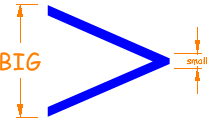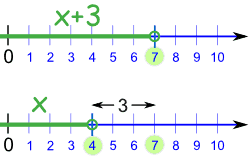Vocabulary
Inequality- states that two quantities either are not equal or may not be equal.
Algebraic Inequality- an inequality that contains a variable. A value of the variable makes the
inequality true is a solution of the inequality.
Solution Set- an inequality may have more than one solution. Together, all of the solutions are the
solution set.
Compound Inequality- the result of combing two inequalities. The words and and or are used to
describe how the two parts are related.
Examples
Sometimes we need to solve Inequalities like these:
|
Symbol
|
Words
|
Example
|
|---|---|---|
| > |
greater than
|
x + 3 > 2
|
| < |
less than
|
7x < 28
|
| ≥ |
greater than or equal to
|
5 ≥ x - 1
|
| ≤ |
less than or equal to
|
2y + 1 ≤ 7
|
Solving
Our aim is to have x (or whatever the variable is) on its own on the left of the inequality sign:| Something like: | x < 5 | |
| or: | y ≥ 11 |
How to Solve
Solving inequalities is very like solving equations ... we do most of the same things ...
... but we must also pay attention to the direction of the inequality.

Direction: Which way the arrow "points"
Some things we do will change the direction!
< would become >
> would become <
≤ would become ≥
≥ would become ≤
Safe Things To Do
These are things we can do without affecting the direction of the inequality:Example: 3x < 7+3
We can simplify 7+3 without affecting the inequality:
3x < 10
- Multiply (or divide) both sides by a negative number
- Swapping left and right hand sides
Example: 2y+7 < 12
When we swap the left and right hand sides, we must also change the direction of the inequality:
12 > 2y+7
Adding or Subtracting a Value
We can often solve inequalities by adding (or subtracting) a number from both sides (just as in Introduction to Algebra), like this:Solve: x + 3 < 7
If we subtract 3 from both sides, we get:
x + 3 - 3 < 7 - 3
x < 4
And that is our solution: x < 4In other words, x can be any value less than 4.
What did we do?
We went from this:
To this:
|
 |
x+3 < 7
x < 4
|
||
Example: Alex has more coins than Billy. If both Alex
and Billy get three more coins each, Alex will still have more coins
than Billy.
What If I Solve It, But "x" Is On The Right?
No matter, just swap sides, but reverse the sign so it still "points at" the correct value!
Example: 12 < x + 5
If we subtract 5 from both sides, we get:
But it is normal to put "x" on the left hand side ...
And that is our solution: x > 7
Note: "x" can be on the right, but people usually like to see it on the left hand side.If we subtract 5 from both sides, we get:
12 - 5 < x + 5 - 5
7 < x
That is a solution!But it is normal to put "x" on the left hand side ...
... so let us flip sides (and the inequality sign!):
x > 7
Do you see how the inequality sign still "points at" the smaller value (7) ?And that is our solution: x > 7
http://www.mathsisfun.com/algebra/inequality-solving.html
Video Help
https://www.youtube.com/watch?v=UTs4uZhu5t8
https://www.youtube.com/watch?v=1Z22Xh66VFM
https://www.youtube.com/watch?v=nuI1eRZR_gU

No comments:
Post a Comment